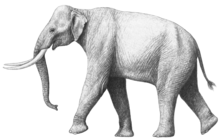Palaeoloxodon recki
| Palaeoloxodon recki Temporal range:
| |
|---|---|

| |
| Size comparison of a 40 year old adult male Palaeoloxodon recki atavus from Koobi Fora | |

| |
| Life restoration by Mauricio Antón | |
| Scientific classification | |
| Domain: | Eukaryota |
| Kingdom: | Animalia |
| Phylum: | Chordata |
| Class: | Mammalia |
| Order: | Proboscidea |
| Family: | Elephantidae |
| Genus: | †Palaeoloxodon |
| Species: | †P. recki
|
| Binomial name | |
| †Palaeoloxodon recki (Dietrich, 1894)
| |
| Synonyms | |
|
Elephas recki Dietrich, 1894 | |
Palaeoloxodon recki, often known by the synonym Elephas recki is an
Taxonomy
The species was initially named from specimens found at Bed IV in
Michel Beden's publications during the 1980s on Elephas recki primarily focusing on molar morphology[4][5][6] identified five successive subspecies, from oldest to youngest with ages according to Sanders (2023)[3]:
- E. r. brumpti Beden, 1980 Early Pliocene-~3.2 million years ago (mya)
- E. r. shungurensis Beden, 1980 ~3.2-2.3 mya
- E. r. atavus Arambourg, 1947 ~2.3-1.8 mya
- E. r. ileretensis Beden, 1987 ~1.8-1.4/1.6 mya
- E. r. recki (Dietrich, 1916) 1.6/1.4 mya-late Middle Pleistocene
For decades after Beden's publications, his view of "Elephas recki" as a succession of subspecies was accepted as orthodoxy. However, Beden's views of Elephas recki evolution were challenged by the work of Nancy Todd published in 2001 and 2005.
A 2020 PhD thesis by Steven Zhang, focusing primarily on skull morphology again challenged the monophyly of Elephas recki as a whole, finding that while E. r. ileretensis and E. recki recki has a close relationship with Eurasian Palaeoloxodon. which genetic data shows is closely related to African elephants (
Outside its core East African distribution. It has also been suggested that material from
Description
Members of the species were larger than any living elephant. A large mostly complete male specimen of P. recki atavus
Ecology
All named subspecies of P/E. recki, regardless of true evolutionary relationships, are thought to have been dedicated grazers, with the molar teeth of later subspecies showing greater adaption to grazing than earlier subspecies.[1]
Evolutionary history
Following the emergence of P. recki in Africa, at the end of the Early Pleistocene, around 800,000 years ago, a population of P. recki recki migrated out of Africa, giving rise to the Eurasian radiation of Palaeoloxodon.
Relationship with humans
At several sites across Africa, remains of P. recki have been found associated with stone tools. In some cases like Olduvai FLK, these are likely coincidental, but in others which bears cut marks, these likely represent evidence of butchery by
Gallery
-
Skull at the Gallery of Paleontology and Comparative Anatomy, France
-
Underside of the skull and lower jaws at the Gallery of Paleontology and Comparative Anatomy
-
Lower jaw at theMuseum für Naturkunde. Berlin
References
- ^ S2CID 198190671.
- ^ .
- ^ ISBN 978-1-315-11891-8.
- ^ Beden, M. 1980. Elephas recki Dietrich, 1915 (Proboscidea, Elephantidae). Èvolution au cours du Plio-Pléistocène en Afrique orientale. Geobios 13(6): 891-901. Lyon.
- ^ Beden, M. 1983. Family Elephantidae. In J. M. Harris (ed.), Koobi Fora Research Project. Vol. 2. The fossil Ungulates: Proboscidea, Perissodactyla, and Suidae: 40-129. Oxford: Clarendon Press.
- ^ Beden, M. 1987. Les faunes Plio-Pléistocène de la basse vallée de l’Omo (Éthiopie), Vol. 2: Les Eléphantidés (Mammalia-Proboscidea) (directed by Y. Coppens and F. C. Howell): 1-162. Cahiers de Paléontologie-Travaux de Paléontologie est-africaine. Centre National de la Recherche Scientifique (CNRS). Paris.
- ^ S2CID 213676377.
- hdl:10072/142575.
- ISSN 0033-5894.
- .
- ISSN 0891-2963.
- S2CID 883007.
- ISBN 978-1-78570-965-4, retrieved 2020-04-14
- ISSN 2571-550X.



